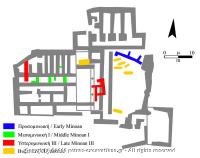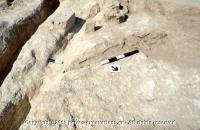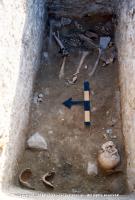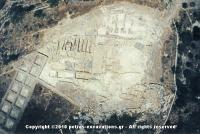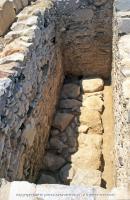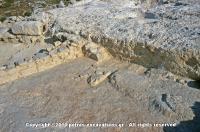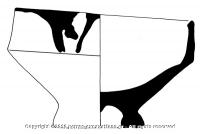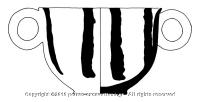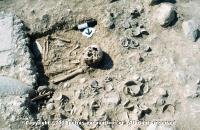Non Palatial Remains In The Area Of The Palace
Ι. The Early Minoan settlement
The earliest organized phase of occupation on the plateau is dated to the Early Minoan II. Various remains of this period have been excavated in stratigraphical trenches below the palace. At the northern end of the plateau a complete Early Minoan II house, with two rooms and another auxiliary area is preserved; its floor was made of good quality red plaster; one of the rooms contained a hearth carved in the floor. During the same period several basin-like carvings on the bedrock at the east and the north-east side of the plateau suggest an industrial activity connected with water.
II. The Middle Minoan buildings
At the end of the Prepalatial period (ΜΜΙΒ) the area of the palace was occupied by one or more buildings, which had the same orientation of the later structure, and were leveled to make place for the palace. A few remains of walls and floors associated with good quality pottery have been excavated beneath the west wing of the palace.
III. Τhe Postpalatial reocupation
By the end of the 15th century, in Late Minoan IIIA, on top of the ruins of the palace, two small houses were erected, one east of the Central Court and the other above the West wing. They were destroyed by fire in the mid 13th century.
IV. The Byzantine cemetery
During the Μiddle Byzantine period (12th cent. AD.), on top of the remains of the minoan palace, a cemetery was established. 33 graves have been excavated, either carved in the soft bedrock, or built with stones taken from the minoan walls, within the thick Late Minoan IB destruction deposit of the palace. Men, women and children were buried in the cemetery. A substantial quantity of pottery was found in the tombs, especially glazed bowls with sgraffito decoration, and many fragments from glass lamps. It is interesting, but not unparalled in this period, that the cemetery was not connected to a church. Ιn the space between the graves many amphorae, plates and bowls of the same byzantine period came to light, suggesting banquets connected with the funerary rituals, a practice still encountered in Crete, and in other areas of Greece today.
- •Μiddle Byzantine period
- •Late Minoan IIIA
- •Prepalatial period ΜΜΙΒ
- •Early Minoan II







